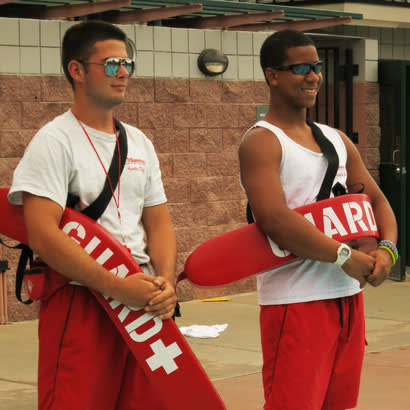
Are your lifeguards prepared for the stress and fear involved in an actual emergency? Intuitively, we know that no 16-year-old lifeguard is going to remain calm with a resting heart rate while performing CPR; yet, we typically train this skill in a relaxed classroom setting.
Standard aquatics trainings will teach and strengthen rescue skills, but they don’t necessarily prepare lifeguards for the psychological and physiological stress of life-and-death situations. To better prepare their staff for real emergencies, aquatic managers can learn from the military research and methods, as outlined by David Grossman in On Combat: The Psychology and Physiology of Deadly Conflict in War and in Peace and Bruce Siddle in Sharpening the Warriors Edge: The Psychology & Science of Training. Just as the military has developed training techniques to prepare soldiers for peak performance in stressful situations, the aquatics industry can incorporate trainings that prepare lifeguards for success during times of fear, stress and physical exertion.
Preparing for emergency action includes recognizing that stress and fear increase the rescuer’s heart rate, sending more oxygenated blood through the body. Physiologically, this improves the strength and endurance of large muscles, but hampers the performance of fine-motor skills. Psychologically, as the heart rate increases, a person’s complex thinking will first heighten and then diminish, while their automatic processing will steadily increase. Incorporating stress training into an aquatic program will give lifeguards the tools they need to perform their skills in an actual emergency.
Military Tactical Drills
There are four types of military tactical drills that can be incorporated in aquatics trainings: speed, exertion, limitation and desensitization. Let’s look more in-depth into two of these drills:
Speed Drills – During speed drills, lifeguards perform a specific task quickly, while being timed. As the lifeguards meet the speed goals of a simple skill, additional skills are added to increase the complexity of the task. Speed drills create muscle memory so that the complex tasks eventually become part of the lifeguard’s automatic response. Here is an example of a speed drill, developed by my colleague Pete DeQuincy, for a passive victim in shallow water:
- Enter the water, get the victim and put the victim on the tube (start with 12 seconds, then steadily reduce time until lifeguards can do it in 6 seconds).
- Add getting the victim to the side of the pool (again, start with 12 seconds, then add a second rescuer and reduce time to 8 seconds).
- Add removing the victim from the pool (keep at 8 seconds).
- Do a head-tilt-chin-lift, check for pulse and position the second rescuer for compressions (allow 10 seconds).
As lifeguards move through the stages of this speed drill, their rescues will look less like text-book skills but should continue to meet all the objectives of a rescue, such as keeping the victim’s airway above the water. The speed drill will allow the lifeguards to build muscle memory so that as their heart rate increases, and they become more reliant on automatic processing, they are still able to meet the objectives of their emergency procedures. Through speed and repetition, the rescue skill becomes so ingrained in the lifeguards that they can perform successful rescues despite the decreased capacity for complexed thinking that often accompanies stressful situations.
Exertion Drills – Similarly, exertion drills require lifeguards to perform skills with an elevated heart rate, but the drills focus on building endurance and/or dexterity. During exertion drills, lifeguards must first exert themselves to raise their heart rate to a minimum of 145 beats per minute (bpm) and then perform a rescue or first-aid skill.
If the drill performed involves gross motor skills, the lifeguards are building their endurance. For example, a lifeguard can tread water, holding a brick for 2 minutes to elevate his/her heart rate, and then perform a submerged victim rescue to improve leg power and endurance. If the drill involves complex motor skills, it will build focus and dexterity. For example, lifeguards can sprint for 50 yards across the pool and then work together to perform a back-boarding exercise to practice the complex skill of in-line stabilization and the fine- motor skills of buckling straps. Here is an example of one of my favorite exertion drills:
- Two lifeguards race across the pool.
- The winner floats on his/her back, and the loser then tows the winner back across the pool.
- The pair gets out of the pool and performs CPR on a manikin.
- Another pair of lifeguards does the same race and tow across the pool.
- The second pair takes over CPR, and the first pair races again.
The trainer will notice that lifeguards who have been performing excellent CPR in the classroom setting are now forgetting simple steps like the pulse check. There are often errors in basic skills, like the head-tilt-chin-lift and hand placement as well. As lifeguards work through these issues, they are learning to sharpen their skills to a level that will be effective even when their heart rate is elevated.
It is important to note that stress training is designed to improve, not to replace, the other components of regular in-service training. Solid rescue skills and emergency action plan (EAP) practice are essential to staff trainings. Also, stress-training techniques should be implemented gradually, so skills can be developed without undermining the lifeguards’ confidence.
Herz will take a deeper dive into applying military science to aquatics trainings, including additional stress-training techniques, improving lifeguard scanning and decreasing the likelihood of lifeguards to panic, in “Stress to Success — Training Lifeguards Using Military Science” at the 2018 NRPA Annual Conference, Wednesday, September 26, 4:15 p.m. – 5:30 p.m.
Becky Herz is the Senior Recreation Services Manager for Sunrise Recreation & Park District.

